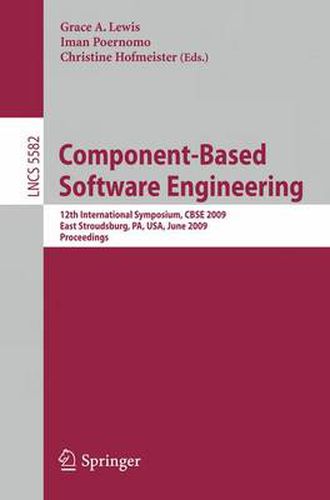Readings Newsletter
Become a Readings Member to make your shopping experience even easier.
Sign in or sign up for free!
You’re not far away from qualifying for FREE standard shipping within Australia
You’ve qualified for FREE standard shipping within Australia
The cart is loading…






This title is printed to order. This book may have been self-published. If so, we cannot guarantee the quality of the content. In the main most books will have gone through the editing process however some may not. We therefore suggest that you be aware of this before ordering this book. If in doubt check either the author or publisher’s details as we are unable to accept any returns unless they are faulty. Please contact us if you have any questions.
The 2009 Symposium on Component-Based Software Engineering (CBSE 2009) was the 12thin a series ofsuccessful eventsthat havegrowninto the main forum for industrial and academic experts to discuss component technology. Component-based software engineering (CBSE) has emerged as the under- ing technology for the assembly of ?exible software systems. In essence, CBSE is about composing computational building blocks to construct larger building blocks that ful?ll client needs. Most software engineers are involved in some form of component-based development. Nonetheless, the implications of CBSE adoption are wide-reaching and its challenges grow in tandem with its uptake, continuing to inspire our scienti?c speculation. Component-based development necessarily involves elements of software - chitecture, modular software design, software veri?cation, testing, con?guration and deployment. This year’s submissions represent a cross-section of CBSE - search that touches upon all these aspects. The theoretical foundations of c- ponent speci?cation, composition, analysis, and veri?cation continue to pose research challenges. What exactly constitutes an adequate semantics for c- munication and composition so that bigger things can be built from smaller things? How can formal approaches facilitate predictable assembly through b- ter analysis? We have grouped the proceedings into two sub-themes that deal with these issues: component models and communication and composition. At the same time, the world is changing.
$9.00 standard shipping within Australia
FREE standard shipping within Australia for orders over $100.00
Express & International shipping calculated at checkout
This title is printed to order. This book may have been self-published. If so, we cannot guarantee the quality of the content. In the main most books will have gone through the editing process however some may not. We therefore suggest that you be aware of this before ordering this book. If in doubt check either the author or publisher’s details as we are unable to accept any returns unless they are faulty. Please contact us if you have any questions.
The 2009 Symposium on Component-Based Software Engineering (CBSE 2009) was the 12thin a series ofsuccessful eventsthat havegrowninto the main forum for industrial and academic experts to discuss component technology. Component-based software engineering (CBSE) has emerged as the under- ing technology for the assembly of ?exible software systems. In essence, CBSE is about composing computational building blocks to construct larger building blocks that ful?ll client needs. Most software engineers are involved in some form of component-based development. Nonetheless, the implications of CBSE adoption are wide-reaching and its challenges grow in tandem with its uptake, continuing to inspire our scienti?c speculation. Component-based development necessarily involves elements of software - chitecture, modular software design, software veri?cation, testing, con?guration and deployment. This year’s submissions represent a cross-section of CBSE - search that touches upon all these aspects. The theoretical foundations of c- ponent speci?cation, composition, analysis, and veri?cation continue to pose research challenges. What exactly constitutes an adequate semantics for c- munication and composition so that bigger things can be built from smaller things? How can formal approaches facilitate predictable assembly through b- ter analysis? We have grouped the proceedings into two sub-themes that deal with these issues: component models and communication and composition. At the same time, the world is changing.